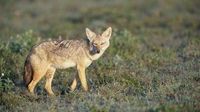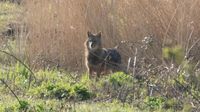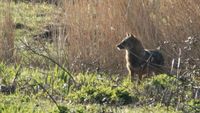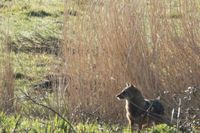A golden jackal, a canid species closely related to wolves and dogs, was spotted for the first time in Normandy, France, marking a significant ecological event. On March 14, 2025, two members of the Photo Club de Bolbec, Marie-Pierre Toll and Sylvie Caramello, photographed the elusive creature in the Seine Estuary National Nature Reserve, located between Le Havre and Tancarville.
The pair, excited by the beautiful weather while out capturing images of local wildlife, stumbled upon a remarkable sight. As Toll recounted, "At one moment, we caught a glimpse of a fox, but before we could take a photo, something emerged from the reeds. We initially thought it was a wolf—our adrenaline was rushing as we shot pictures without adjusting our settings." The creature's appearance was startling—it was not a fox or a wolf, but a golden jackal, officially identified shortly after.
According to the Office français de la biodiversité (OFB), the golden jackal (Canis aureus) hails from Asia and has expanded naturally into Europe. Its morphology presents a blend resembling both wolves and foxes, with the general characteristics of a scavenger and a predator. These features make it a critical player in the ecosystem, occupying a niche similar to that of the fox. "It’s a generalist predator and scavenger that occupies an ecological niche close to that of the fox," said Cyril Tellier, a specialist in canids at the Direction départementale des Territoires et de la Mer.
The golden jackal, measuring between 45 to 50 cm at the shoulder and 65 to 105 cm in length, has been gradually making its way into different regions of France. The first sightings in the country were reported in 2017 in Haute-Savoie, and since then, the species has appeared in various departments including Deux-Sèvres, Bouches-du-Rhône, Essonne, Alpes-Maritimes, and most recently in Finistère.
This particular sighting in Normandy is remarkable, as it signifies the ongoing natural expansion of the species into new territories. Tellier noted, "We knew we would eventually see them in our area, but witnessing one in broad daylight like this is exceptional." The golden jackal’s adaptability to diverse habitats, from forested areas to marshes, allows it to thrive alongside other species.
The presence of the golden jackal has generated excitement as well as calls for responsible wildlife interaction. Both Toll and Caramello underscored the importance of respecting wildlife, emphasizing that all species deserve tranquility. This message was echoed by officials of the Seine Estuary reserve, who cautioned that during the breeding season, visitors should keep their dogs leashed to prevent potential disturbances.
Jean-Michel Vandel, an expert from the biodiversity office, reiterated, "In France, it is a species that can neither be hunted nor trapped, making it protected under European natural heritage laws." This protection status is crucial for the conservation of the golden jackal as it establishes itself within French ecosystems.
The recent discovery follows a backdrop of heightened wildlife observation in the region, especially amidst ongoing discussions about wildlife management and the interaction between various species within shared habitats. The balance between preserving these species while managing livestock safety concerns continues to be a point of focus for local authorities and environmentalists alike.
Previous to this sighting, there were incidents reported involving large canids, including a carcass found along the A131 highway in Sandouville which may have been a wolf, stirring interest about the resurgence of canid species in the area. The local prefecture recently announced the end of searches for a humpback whale reported in the Seine, underscoring the dynamic nature of wildlife interactions in this unique environment.
With the golden jackal now part of the natural panorama in Normandy, experts will closely monitor its activities. The OFB has committed to ongoing surveillance to learn how these animals establish and colonize new territories.
These interactions not only spotlight the adaptability and resilience of nature but also remind us of our role as stewards of the environment. Observing wildlife—whether a golden jackal or any other species—should be a reminder to respect their space and encourage conservation efforts.
In this evolving narrative of wildlife in France, the golden jackal serves as a symbol of nature's ongoing journey, inviting not just admiration but also responsibility from the people who share its habitat.

![[Insolite] Seine-Maritime. Un chacal doré a été aperçu près du pont de Normandie](https://thumbor.evrimagaci.org/4yO5zNZPxQCwBKIpHS2JIEpTyFo=/200x0/tpg%2Fsources%2F3032b049-a932-4dfc-a38a-e5ae2ce56fc0.jpeg)






